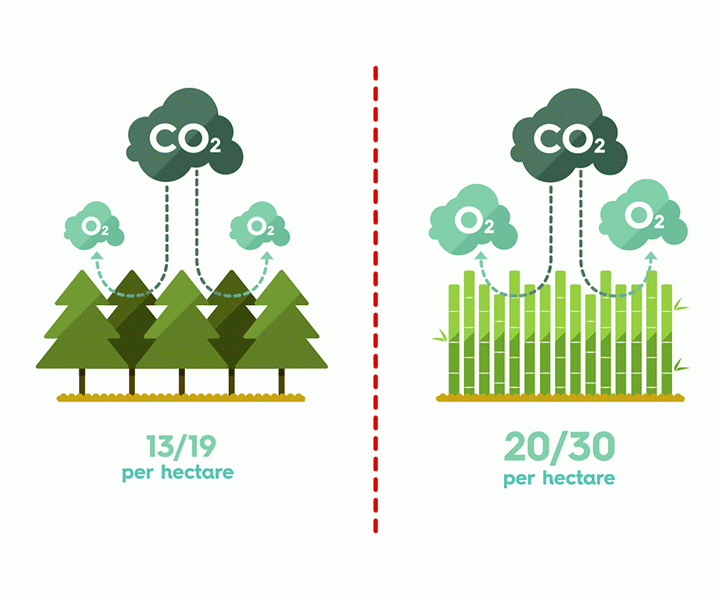Bamboo - Air Filtration
Bamboo absorbs 5 times more CO2 and produces 35% more O2 compared to other woody plants.
This special feature of bamboo is due to its rapid growth and ability to mature within a few years. The high growth rate requires bamboo to absorb a large amount of CO2 from the air in a short period and use it to develop leaves, stems, and roots.
A study has shown that one hectare of bamboo can store about 60 tons of CO2 over 20 years, nearly equivalent to the amount of CO2 emitted by an average car driving about 12,000 km per year.
More details:
Bamboo: Natural CO2 Absorbing and O2 Producing Machine
In the context of increasingly severe climate change and environmental pollution, finding natural solutions to reduce CO2 emissions and increase O2 levels has become essential. Bamboo, a member of the Poaceae family, is not only famous for its rapid growth rate but also for its impressive CO2 absorption and O2 production capabilities, significantly contributing to air purification and environmental protection.
Bamboo's CO2 Absorption Features
Bamboo's effective CO2 absorption is due to its fast growth rate and large leaf area. Each hectare of bamboo forest can absorb about 60 tons of CO2 per year, five times more than conventional woody plants. The main features that help bamboo absorb CO2 efficiently include:
Large leaf area: Bamboo has a wide canopy, maximizing the surface area exposed to the air, enhancing photosynthesis capability.
Rapid growth rate: With its fast development, bamboo can continuously absorb CO2 throughout its growth period. Some bamboo species can grow up to 91 cm per day, optimizing the CO2 absorption process.
Unique biological structure: Bamboo stems have a distinct structure with clear nodes and hollow interiors, optimizing gas exchange and carbon storage in the stems.

Bamboo's O2 Production and Benefits
Bamboo's photosynthesis process not only helps absorb CO2 but also produces O2, a crucial element for the survival of all living organisms. Bamboo's impressive O2 production capability is attributed to the following features:
Efficient photosynthesis: Bamboo performs vigorous photosynthesis, converting CO2 and water into sugars and O2 under sunlight. Each hectare of bamboo forest can produce up to 35 tons of O2 per year.
High growth rate: Due to its fast growth rate, bamboo can maintain more efficient photosynthesis over a short period, contributing to higher O2 production.
Greenhouse gas reduction: Thanks to its effective CO2 absorption, bamboo helps reduce the amount of greenhouse gases in the air, contributing to combating global warming.
Providing O2: The O2 produced by bamboo helps improve air quality, supporting the life of humans and animals.
Soil protection: Bamboo's strong root system helps prevent soil erosion, protecting the soil from being washed away and maintaining its fertility.
Bamboo is not only a sustainable raw material source but also a highly effective natural machine for absorbing CO2 and producing O2. With its outstanding features and significant contributions to air purification and environmental protection, bamboo will undoubtedly continue to assert its important role in building a green and sustainable future, bringing great benefits to humans and the planet.
